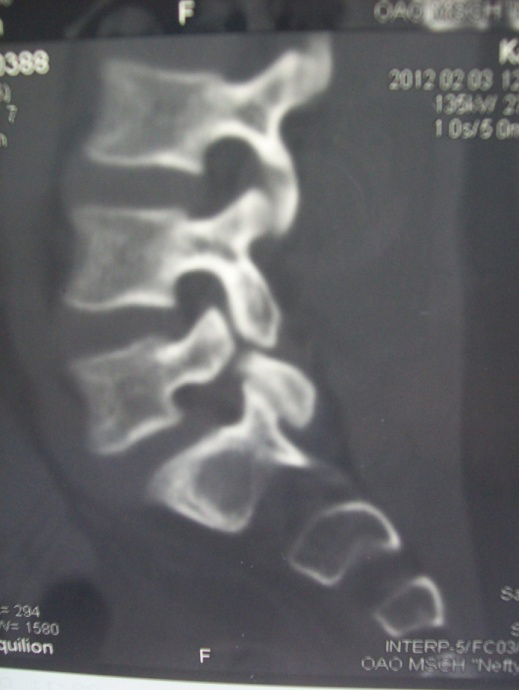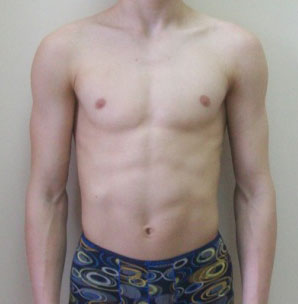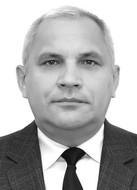Spinal traumas and disorders prevention in athletic training process
Фотографии:
ˑ:
Dr.Med., Professor E.G. Skryabin1
PhD, Associate Professor E.T. Kolunin2
1Tyumen State Medical University, Tyumen
2Tyumen State University, Tyumen
Keywords: athletic training, spinal cord diseases, spondylolysis, spondylolisthesis.
Introduction. Athletes’ physical health and full-fledged sports activity are interrelated aspects of productive life of modern man. It is difficult to imagine an individual, including a child, with serious health problems ever doing sports to the utmost and achieving high sports results.
Sporting children often complain about low back pain. The literature analysis and first-hand clinical experience indicate that a common cause of such pains is a serious constitutional pathology – spondylolysis or spondylolisthesis in the fifth lumbar vertebra [1, 2, 7, 8, 10].
Objective of the study was to diagnose and prevent injuries and diseases that cause low back pain (lumbago) in athletes of different age groups.
Methods and structure of the study. The spinal cord pathology was diagnosed based on the complaints, anamnesis, clinical examination, X-ray study, computed tomography and magnetic resonance imaging. The article presents the results of the 3-7-year case monitoring and treatment of 98 sporting children (55 boys and 43 girls) aged 10 to 16 years, all having different qualifications and engaged in different sport disciplines (rhythmic and artistic gymnastics, figure skating, Greco-Roman wrestling, judo, football and hockey). The study was conducted from 2013 through 2017 in Tyumen.
Results and discussion. The study revealed that the low back pain in sporting children appeared after 3-5 years of active sports, i.e. at the training stage or, as they call it, advanced sport specialization stage. The pain usually appeared during the training session or immediately after it. Rest, especially in the horizontal position, helped relieve pain without taking medications. However, each successive training session usually resulted in the appearance of the same pain syndrome.
The analysis of the training process content showed that the pain syndrome formation was promoted by hyperextension in the lumbar spine coupled with a large number of other exercises that provide vertical and torsion load on the spine (weightlifting in a standing position, jumping, sharp torso turns, etc.). Such physical practices, when they are long enough, as well as the absence of special decompression techniques are associated with the growing risks of spondylolysis and spondylolisthesis in some children.
High-amplitude lumbar spine movements in the sagittal plane, particularly overextension (hyperextension), impose excessive load on the pars interarticularis of the fifth vertebral arch [6, 10]. In this position, the lower articular process of the overlying, fourth, lumbar vertebra exerts pressure on the interarticular part of the vertebral arch, which due to months-long and years-long loads may result in a zone of pathological restructuring of bone tissue, the so-called "Looser zone", or fatigue fracture zone, - spondylolysis (unilateral or bilateral) [2, 4, 6, 10].
In roughly half the instances, especially when physical practices are long enough, spondylolysis can lead to a more serious pathology - spondylolisthesis in the LV vertebra (anterior or posterior slipping or displacement of one vertebra compared to another). Most likely, in some patients, especially if the pathology is diagnosed in the preschool and primary school age, spondylolysis in the pars interarticularis of the LV vertebral arch is a congenital disease [4, 6]. The study made it possible to diagnose bilateral spondylolysis in the pars interarticularis of the fifth vertebral arch in 27% of the examined patients, and I-II degree spondylolisthesis in the fifth lumbar vertebra - in 73% of the examined athletes.
The lumbar spine lateral X-ray and tomographic images illustrate this condition as a gap between the superior and inferior articular processes of the fifth lumbar vertebra (see the photo).

a

b
Photo of 16 year-old patient M., engaged in Greco-Roman wrestling for 4 years (a), and his lumbar spine computer tomographic image (b). Pars interarticularis defect in the LV vertebra (spondylolysis)
It should be noted that spondylolysis and vertebrogenic pain syndrome appear not in all children and adolescents actively doing sports, including those who perform hyprextension exercises during their training and competitive activities. This is due to the anatomical and physiological characteristics of the growing spine, which contribute to the formation of spondylolysis, as confirmed by the scientific publications. Scholars contend that such individual characteristics are: various congenital anomalies of lumbosacral localization, trapezoidal shape of the fifth lumbar vertebra, dome shape of the upper part of the sacrum, vertical position of the sacrum, sagittal vertebral-pelvic imbalance, appearance and progression of degenerative changes in the intervertebral disc LV- SI [1, 2, 4, 7, 10]. The above and some other dysplastic changes in the lumbosacral junction were diagnosed in 88% of the examined athletes.
Against the background of the existing changes in the spine and pelvic ring, excessive load on the pars interarticularis of the fifth vertebral arch leads first to the formation of spondylolysis, and may further result in spondylolisthesis [10]. The clinical evidence of this is the low back pain, which significantly limits the sporting children’s motor activity. All examined subjects complained of lumbar pain. In addition to the pain syndrome caused by spondylolysis and spondylolisthesis in the fifth lumbar vertebra, the athletes were diagnosed with other symptoms of the pathology. The most severe and clinically significant of them were as follows: tension of the lumbar spine extensors (80.76%), lumbar hyperlordosis (76.92%), impaction of the spinous process of the displaced LV vertebra (57.69%), malfunction (42.3%), tenderness on palpation (84.61%), painful axial loading (65.38%).
Based on the study data, the children diagnosed with the lumbar spinal disorders are recommended to abstain from spine stretching, jumping and standing/ sitting weight training practices or weight carrying practices. That is, it is necessary to minimize vertical loading on the spine. Also, it is recommended to exclude exercises aimed to increase the lumbar-spine mobility, as they lead to loosening of the intervertebral joints and strengthening of the spinal instability (arching backward from different initial positions, crab position, etc.). Picked sit is also dangerous for the intervertebral discs, especially in the lumbar region. When performing exercises in the prone position, the movements are often amplified, i.e. excessive leg-raising can lead to the appearance of excessive lordosis in the lumbar region and increased pelvic angle. Tension in the occipital region can be due to lifting of the shoulders to the head and excessive neck extension [3, 5].
Conclusion. Early diagnosis of spinal cord diseases makes it possible to adequately treat them, and thereby prevent unpleasant consequences, primarily intervertebral hernia, these diseases can lead to being diagnosed untimely. Coaching specialists are to take their trainees’ complaints as seriously as possible, especially when they say time and again about lumbar-sacral pains appearing during the training session or immediately after it, and refer them to competent traumatologists and orthopedists.
References
- Bannikova R.A., Andruskaya O.A., Pogrebnyak A.A. Vertebralnye bolevye sindromy u podrostkov: diskussionnye voprosy [Vertebral pain syndromes in adolescents: discussion issues]. Sportivnaya meditsina, 2014, no. 1, pp. 25-31.
- Delyagin V.M. Boli v poyasnitse u fizicheski aktivnykh podrostkov [Back pain in physically active adolescents]. Sportivnaya meditsina: nauka i praktika, 2016, no. 4, pp. 86-92. DOI: 10. 17238/ISSN2223-2524.2016.4.86.
- Kolunin E.T. Konvergirovanie sredstv gimnastiki v protsesse nachalnoy podgotovki sportivnogo rezerva [Gymnastic means convergence in initial training process of sports reserve]. Teoriya i praktika fiz. kultury, 2015, no. 12, pp. 22-25.
- Mikhaylovskiy M.V., Sadovoy M.A., Belozerov V.V. Skolioz i spondilolistez: obzor literatury [Scoliosis and spondylolisthesis: literature review]. Khirurgiya pozvonochnika, 2017 no. 3, pp. 23-31. DOI: 10.14532/ss2017.3.23-31.
- Prokopyev N.Ya., Kolunin E.T. Profilaktika obostreniy dizontogeneticheskikh zabolevaniy pozvonochnogo stolba u detey mladshego i srednego shkolnogo vozrasta na urokakh fizkultury [Prevention of exacerbations of dysontogenetic diseases of spinal column in primary and secondary school children at physical education classes]. Fizicheskaya kultura: vospitanie, obrazovanie, trenirovka, 2001, no. 2, P. 59.
- Skryabin E.G. Spondiloliz i spondilolizny spondilolistez LV pozvonka u detey doshkolnogo i mladshego shkolnogo vozrasta [Spondylolysis and spondylolysis in the LV vertebra in pre-school and primary school children]. Vestnik novykh meditsinskikh tekhnologiy, 2014, no. 3, pp. 72-76. DOI: 10.12737/5903.
- Skryabin E.G. Spondiloliz i spondilolizny spondilolistez nizhnikh poyasnichnykh pozvonkov u detey i podrostkov [Spondylolysis and spondylolisthesis of lower lumbar vertebra in children and adolescents]. Geniy ortopedii, 2017, no. 1, pp. 71-73. DOI: 10.1809/1028-4427-2017-23-1-71-73.2.
- Assad A.P., Abreu A.S., Seguro L.P. Spondyloptosis in athlete. Rev. Bras. Reumatol., 2014, vol.54 (3), pp.234-236.
- Bartochowski L., Jurasz W., Kruczynski J. A minimal soft tissue damage approach of spondylolysis repair in athletes: preliminary report. Eur. J. Orthop. Surg. Traumatol., 2017, vol.5, pp.12-17. DOI: 10.1007/s00590-017-1974-0.
- Grodahl L.H., Fawcett L., Nazareth M. Diagnostic utility of patient history and physical examination data to detect spondylolysis and spondylolisthesis in athletes with low back pain: a systematic review. Man. Ther., 2016, vol. 24, pp. 7-17. DOI: 10.1016/J.math.2016.03.011.
Corresponding author: skryabineg@mail.ru
Abstract
Subject to combined medical examinations under the study were the 10-16 year-old trainees (n=98) specializing in different sport disciplines and diagnosed with lumbar-sacral pains due to spondylolysis (defect in the pars interarticularis of the vertebral arch) and spondylolisthesis (anterior or posterior slipping or displacement of one vertebra compared to another). It was found that the pain appeared after 3-5 years of active sports at the advanced sport specialization stage. The pains followed by pathologies were generally reported to occur as a result of strenuous physical loads and special lumbar segment overstretching exercises. Such physical practices, when they are long enough, are associated with the growing risks of spondylolysis and spondylolisthesis in the LV vertebra. The authors list the key symptoms of the lumbar spinal disorders. Based on the study data, we recommend that in case of such complaints the coach should refer junior athletes to competent traumatologists and orthopedists. The children diagnosed with the lumbar spinal disorders are recommended to abstain from spine stretching, jumping and standing/ sitting weight training practices or weight carrying practices.



